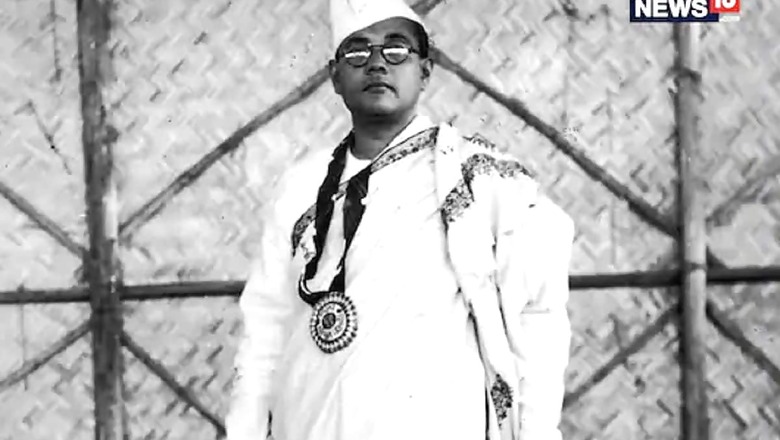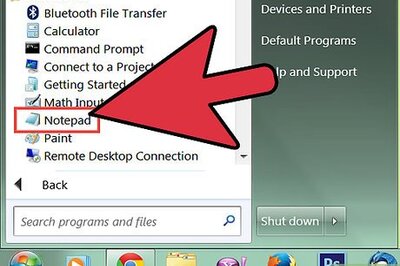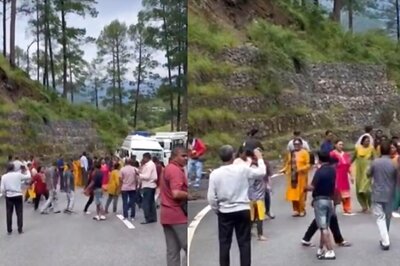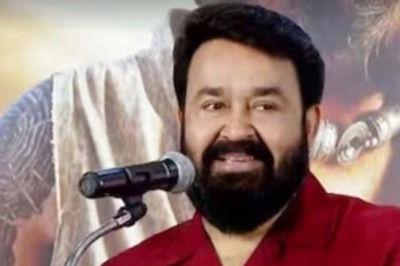
views
The controversy over the new portrait of Netaji Subhas Chandra Bose unveiled at Rashtrapati Bhavan is borne out of the same petty-mindedness that either belittled or tried to omit his contribution in the freedom struggle. But the country is not going to be conned again. The whole nation now knows about Netaji’s contributions and his contributions are talked about by people openly.
Just three days ago, Netaji’s 125th birth anniversary was celebrated by the whole country as Parakram Diwas with much gusto. But a day before the Republic Day celebrations, some people tried to rake up a needless controversy. They included some politicians, intellectuals and journalists as well. Their claim was that the portrait President Ramnath Kovind unveiled on January 23 was not of Netaji but Bengali film star Prosenjit Chatterjee who played Subhas Chandra Bose in ‘Gumnami’, depicting the last days of the freedom fighter’s life.
Gumnami was made in Bangla and released on October 2, 2019. It was a strange coincidence that the film was released on the birth anniversary of Mahatma Gandhi who was the main reason behind Bose’s resignation from the post of the president of the Congress party before his term could be completed due to ideological differences. This also led to his exit from the Congress itself later. The film Gumnami was based on the report of the Mukherjee Commission which was formed on the order of the Supreme Court when Atal Bihari Vajpayee was the Prime Minister of the country in 1999. But this commission submitted its report in 2005 which was rejected by the-then UPA government under Manmohan Singh in 2006. The reason was that the commission did not toe the official line that continued from the Nehru era which was based on the basic premise that Netaji died in a plane crash.
The controversy over the death of Netaji, which started on August 18, 1945, is not yet settled. It was said that on that day the plane which Netaji was travelling in crashed in Taiwan and he died in the tragedy. Four official investigations were carried out to unravel the mystery of his death but the row refuses to die down.
Under such circumstances, some people will find it easy to kick up a row over Netaji’s portrait. However, the artist, who has painted the image based on an actual photograph, has given a befitting reply to the mischief-mongering intellectuals. The creator of the portrait, Paresh Maity, is well known in the world of art. Maity says he painted the portrait on the basis of a real photograph of Bose and not an image from the film Gumnami starring Prosenjit.
After Maity’s statement, many who were seeing a resemblance with Prosenjit in the Netaji portrait have withdrawn their tweets and statements. If you look at it from another angle, this indicates the arrival of a new era. For long, efforts were made to belittle the contribution of Netaji Subhas Chandra Bose in India’s freedom struggle. And the same people stoked this row over his portrait.
As far as Netaji is concerned, he was a man of many faces, a master of disguises. When he escaped from the country, despite the British administration in India keeping a close eye on him, during the Second World War in a bid to free India by defeating the English with the help of Germany and Japan, he did so by disguising himself very differently from his public image of a military leader.
In his book ‘My Uncle Netaji’, Subhas Chandra Bose’s nephew AN Bose says that on the intervening night of January 17 and 18 in 1941, when Netaji boarded the Delhi-Kalka Mail at Gomoh station, he was disguised as a Pathan. He was pretending to be the travelling inspector of the Empire of India Life Assurance Company. Netaji came to Peshawar from Delhi by Frontier Mail where he met the leader of his Forward Bloc party Mian Akbar Shah of the North West Frontier Province, and with him he planned to reach Kabul. His aim was to reach Russia from there and then head to Germany.
As per his plan, Netaji had left the house of his nephew in Barari in Dhanbad on the evening of January 17, 1941, and had caught the train at Gomoh station. This place is now known as Netaji Subhas Chandra Bose station in the memory of that historic incident. Lalu Prasad Yadav is credited for the renaming of this station on Subhas Jayanti, January 23, 2009, when he was railway minister.
After leaving Gomoh station, Netaji never returned to Kolkata ever again. Not even to his house at 38/2, Elgin Road, which hosted Prime Minister Narendra Modi on January 23, 2021. The PM was there to pay floral tributes on Netaji’s 125th birth anniversary. It was the Modi government’s decision to celebrate the day as Parakram Diwas. Netaji played a very important role in the freedom struggle of the country: at times as the president of the Congress, at other times as the founder of the Forward Bloc, and on other occasions as the leader of the Indian National Army. It is the biggest example of valour by a single leader in the freedom struggle.
The British government, which was known for its robust administration and boasted of a huge network of spies, could not get the wind of Netaji leaving India. They came to know about his Great Escape only after ten days, when on January 27, 1941, Bose did not appear in court in connection with a case. There was a time when the sun did not set on the British empire, but it could never get its hands on Netaji ever again. Bose created a strong military challenge for the British empire when he reached the eastern border of India with a huge force of his Indian National Army, and for a brief period he established the rule of INA over the Andamans and certain other parts as Japan had entrusted the administration of these areas to him. But, despite that, there has been very little talk of the achievements of Subhas Chandra Bose compared to some other leaders.
It was not expected that Netaji would get his due in the reign of those who were the ideological heirs of Mahatma Gandhi. It was also not expected that historians who were nurtured by the Nehru-Gandhi family would be ready to accept that Netaji played any important role in the freedom struggle. It is another matter that the way the Indian National Army was formed under the leadership of Bose, and many Indians who were part of the British Indian army joined it, the British government could no longer trust that it could maintain its hold over India with military might. Whatever confidence it had left must have been shaken by the Naval Mutiny that happened in Bombay, inspired by Bose’s INA.
Whether India got its freedom because of the policy of non-violence and Satyagrah of Mahatma Gandhi or the armed struggle under the leadership of Subhas Chandra Bose will be decided in the coming decades when the country and society will be out of the shadow of one kind of ideology. This process is already underway and that is the reason why some people are fuming over the unveiling of the portrait of Netaji at Rashtrapati Bhavan. Though those who know history, know it well that Netaji and the legacy of his ideology has not been dented much by such controversies. After all, Netaji had challenged the ideology of Gandhi and had defeated the candidate of his camp, Pattabhi Sitaramayya, in the election that was held to choose the Congress president in January 1939. At that time, even Mahatma Gandhi had accepted that the defeat of Sitaramayya was his own defeat. But this did not stop Subhas Chandra Bose from registering his win. It needs to be remembered that in those days, a false myth had been created that not only the Congress but the whole country danced to the tune of Gandhi. After eight decades, this untruth has once again been defeated. Truth has won. Though this does not concern Netaji himself but his likeness.
Read all the Latest News, Breaking News and Coronavirus News here



















Comments
0 comment